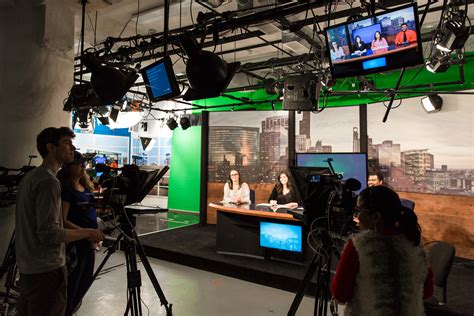Are you passionate about journalism and storytelling? Are you intrigued by the fast-paced world of broadcast journalism? Join me on an exciting journey as we delve into the dynamic and exhilarating world of broadcast journalism. In this blog post, we will explore the multifaceted role of broadcast journalists, gain insider insight into the newsroom environment, and learn the art of crafting engaging news stories. We will also uncover the techniques and strategies behind conducting impactful interviews, and the delicate balance of accuracy and timeliness in reporting breaking news. Additionally, we will discuss the evolving landscape of broadcast journalism in the digital age, including the utilization of social media for breaking news coverage and navigating ethical challenges. Whether you’re an aspiring journalist, a media enthusiast, or simply curious about the inner workings of broadcast journalism, this blog post will provide valuable insight into the captivating world of broadcast journalism.
Table of Contents
Understanding the Role of Broadcast Journalists
Broadcast journalists play a crucial role in delivering news and information to the public through various media platforms. They are responsible for gathering, verifying, and reporting news stories to the audience, ensuring that the information presented is accurate, timely, and engaging.
These professionals work in fast-paced environments, often facing tight deadlines and unpredictable situations. They must stay updated on current events, conduct interviews, and craft compelling stories that resonate with viewers and listeners.
As the media landscape continues to evolve, broadcast journalists are also adapting to new technologies and platforms, incorporating social media and digital tools into their reporting. They are tasked with delivering breaking news updates in real-time, engaging with the audience, and navigating ethical challenges in their profession.
Overall, the role of broadcast journalists is multifaceted, requiring a unique blend of storytelling skills, critical thinking, and a commitment to delivering accurate and impactful news coverage to the public.
Gaining Insight into the Newsroom Environment
Working in a newsroom can be fast-paced, stressful, and full of unexpected challenges. Journalists working in this environment not only have to be able to keep up with the latest developments in current events, but also have the skills to report on them accurately and effectively.
Newsrooms are often noisy, bustling places, with reporters, editors, and producers working together to create engaging news stories. It can be a high-pressure environment as journalists strive to meet deadlines and break stories before their competitors.
Journalists in a newsroom must be adaptable, able to think on their feet, and have a deep understanding of the news cycle. They need to be able to multitask, juggling multiple stories and sources, and constantly monitoring breaking news for any potential impact on their own reporting.
Overall, gaining insight into the newsroom environment takes a combination of skills, including strong communication, time management, and the ability to work efficiently under pressure.
The Art of Interviewing: Techniques and Strategies
Interviewing is a crucial skill for broadcast journalists, as it forms the basis of news reporting. It is the primary method through which journalists gather information, seek clarity on a story, and present different perspectives to their audience. Mastering the art of interviewing requires a combination of techniques and strategies that can help journalists elicit valuable information from their subjects.
One important technique is active listening, which involves paying close attention to the interviewee’s responses, asking follow-up questions, and acknowledging their input. This not only helps in obtaining detailed and insightful answers but also shows respect for the interviewee’s viewpoint.
Another essential strategy is thorough research. Before conducting an interview, journalists should gather as much background information as possible about the topic and the interviewee. This not only demonstrates professionalism but also allows for more targeted and informed questioning, leading to a more in-depth and engaging conversation.
Moreover, effective communication skills, such as maintaining eye contact, using open body language, and being empathetic, can help create a comfortable and trusting atmosphere during the interview. This can encourage the interviewee to share more candid and detailed information, making for a more compelling story for the audience.
Crafting Engaging News Stories
Crafting engaging news stories is a critical aspect of broadcast journalism. It involves the skillful and strategic use of language, visuals, and sound to captivate and inform the audience. To achieve this, journalists must carefully select newsworthy topics, conduct thorough research, and employ creative storytelling techniques.
One of the key elements in crafting engaging news stories is the use of compelling headlines that grab the reader’s attention. A well-crafted headline should be concise, descriptive, and thought-provoking, enticing the audience to delve further into the story.
Additionally, journalists must focus on story structure and pacing to keep the audience engaged. This involves organizing the information in a logical and compelling manner, using transitions and visual elements to maintain the flow of the narrative.
Another crucial factor in crafting engaging news stories is the incorporation of human interest elements. Adding personal anecdotes, interviews, and emotional angles can help connect the audience to the story on a deeper level, making it more relatable and impactful.
Balancing Accuracy and Timeliness in Reporting
When it comes to reporting the news, accuracy and timeliness are two crucial factors that journalists must balance. On one hand, it’s important to deliver the news as quickly as possible to keep the public informed. On the other hand, the information must be accurate and verified to avoid spreading misinformation.
Journalists often face the pressure of breaking news situations, where there’s a race to be the first to report a story. However, rushing to release information without proper fact-checking can result in inaccurate reporting. This can damage the credibility of the journalist and the news organization.
One way to balance accuracy and timeliness is to prioritize thorough research and verification of sources. This may mean taking the time to gather multiple perspectives and cross-checking information before publishing a story. While this approach may delay the release of the news, it ensures that the information is reliable.
Additionally, journalists can make use of technology to aid in the verification process. Fact-checking tools and digital platforms can help to quickly assess the credibility of sources and information, enabling journalists to maintain accuracy while meeting tight deadlines.
Utilizing Social Media for Breaking News Coverage
In today’s rapidly evolving digital landscape, the role of social media in breaking news coverage has become increasingly prominent. With the widespread use of platforms such as Twitter, Facebook, and Instagram, news organizations are leveraging these tools to deliver real-time updates and engage with their audience in a way that was not possible in the past.
Utilizing social media as a source for breaking news coverage allows journalists to gather firsthand accounts and eyewitness reports from individuals who are at the scene of a breaking news event. This has the potential to provide a level of detail and authenticity that traditional reporting methods may not be able to achieve, giving audiences a more comprehensive understanding of the situation as it unfolds.
Furthermore, social media platforms play a crucial role in distributing breaking news content to a wide audience instantaneously. By using hashtags and trending topics, journalists can ensure that their coverage reaches a broader audience, increasing the overall impact of the story and keeping the public informed in real time.
However, it is important for journalists to approach social media with caution, as misinformation and fake news can spread rapidly. Fact-checking and verification of sources are critical in ensuring the accuracy and reliability of breaking news coverage that is disseminated through social media channels.
Mastering the Art of Live Reporting
Live reporting is a critical aspect of broadcast journalism, requiring journalists to think on their feet and deliver accurate, up-to-the-minute information to their audience. The pressure of reporting live can be intense, but mastering this art is essential for any broadcast journalist.
One of the key techniques for mastering live reporting is to always be prepared. This means doing thorough research on the topic at hand, understanding the context and background, and being well-versed in the key points to be covered. Having a clear and concise script can help keep the journalist on track and ensure the information is communicated effectively.
Additionally, mastering the art of live reporting involves being able to think quickly and adapt to changing circumstances. This means being able to handle unexpected developments, such as technical issues or interruptions, while maintaining professionalism and composure.
Another important aspect of live reporting is the ability to engage with the audience. Journalists must be able to communicate clearly, maintain eye contact with the camera, and convey a sense of authority and expertise. Building a rapport with the audience is essential for creating a connection and ensuring that the information is effectively conveyed.
Navigating Ethical Challenges in Broadcast Journalism
As a broadcast journalist, it is crucial to be vigilant about the ethical challenges that may arise in the field. The ethics of journalism play a critical role in maintaining the integrity and credibility of news reporting. It is essential to navigate these challenges with a strong commitment to truth and accuracy.
One of the major ethical challenges in broadcast journalism is ensuring fairness and balance in reporting. It is essential to present all sides of a story in an unbiased manner, giving a voice to diverse perspectives and avoiding the perpetuation of stereotypes or biases. Journalists must strive to represent the complexities of issues and avoid oversimplification.
Furthermore, the privacy and dignity of individuals must be respected in the process of news gathering and reporting. It is crucial to obtain informed consent when dealing with sensitive information or sensitive situations, and to exercise discretion and sensitivity when reporting on personal tragedies or private matters.
Another ethical consideration in broadcast journalism is the responsible use of technology and social media. Journalists must uphold professional standards in their online presence and refrain from sharing unverified information or engaging in clickbait tactics for the sake of sensationalism.
Delivering Impactful Breaking News Headlines
When it comes to delivering impactful breaking news headlines, broadcast journalists must be able to capture the attention of their audience with concise and engaging language. It is crucial for journalists to convey the urgency and significance of the breaking news story while also providing enough information to inform the public.
Utilizing social media platforms such as Twitter, Facebook, and Instagram can be an effective way to reach a wide audience with breaking news headlines. By crafting compelling and eye-catching headlines, journalists can quickly disseminate important information to the public and encourage them to seek out the full story.
Balancing the need for timeliness with the necessity of accuracy is vital when delivering breaking news headlines. Journalists must work quickly to get the story out, but they must also ensure that the information is verified and factual before sharing it with the public.
Overall, delivering impactful breaking news headlines requires a combination of strong writing skills, a deep understanding of the newsroom environment, and a commitment to ethics and accuracy in reporting. By mastering the art of crafting engaging and informative headlines, broadcast journalists can play a crucial role in keeping the public informed during critical breaking news events.
The Future of Broadcast Journalism: Digital Transformation
In today’s fast-paced digital landscape, the field of broadcast journalism is undergoing a significant transformation. With the rise of social media, streaming platforms, and digital news outlets, the traditional methods of delivering news are rapidly evolving. This digital revolution has not only changed the way news is consumed but also how it is produced and distributed.
One of the key aspects of this digital transformation is the shift towards multi-platform journalism. Broadcast journalists are no longer confined to delivering news solely through television or radio. They are now expected to engage with audiences across various digital platforms, including social media, podcasts, and mobile apps. This diversification of journalistic channels has created new opportunities for reaching and connecting with audiences.
Furthermore, the advent of data journalism is another significant development in the digital transformation of broadcast journalism. With the abundance of digital data and analytics tools, journalists can now uncover and present stories in a more fact-based and visually compelling manner. This has not only enhanced the credibility and impact of news reports but has also allowed for greater transparency and accountability in journalism.
Additionally, the digital transformation has brought about a redefinition of newsroom dynamics. Collaborative digital tools and platforms have enabled journalists to work more efficiently and collaboratively across different locations, ultimately leading to more diverse and versatile news coverage.






